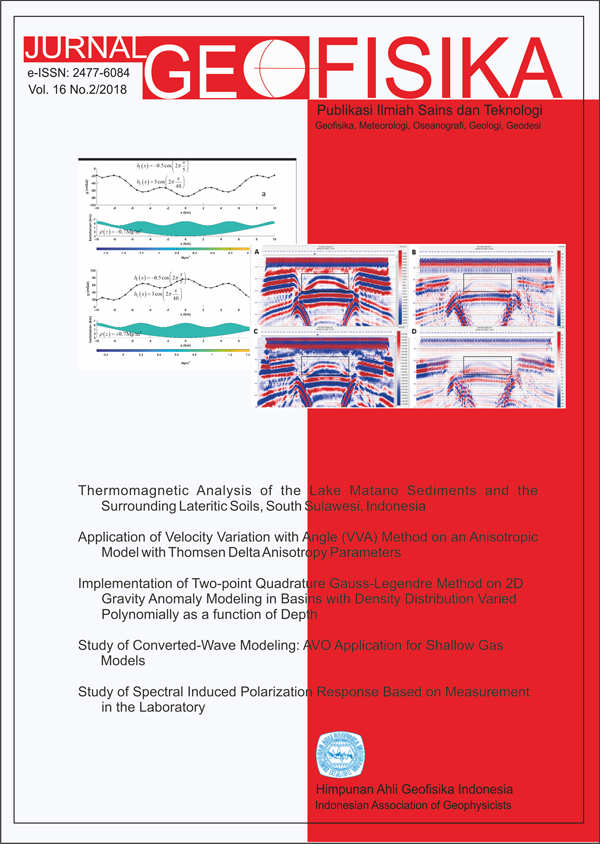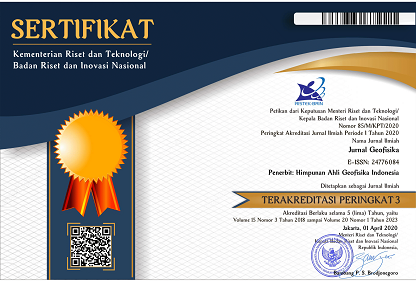Study of Converted-Wave Modeling: AVO Application for Shallow Gas Models
Keywords
converted-wave, AVO, shallow gas, salt domeAbstract
The application of converted-wave seismic method in hydrocarbon exploration has increased significantly. Since the conventional seismic ceases to provide an adequate result in complex geology area and it provides an ambiguous brightspot response. The main principle is that an incident P-wave produces reflected and converted P and SV wave when the downgoing P-wave impinges on an interface. Converted-wave seismic uses the multicomponent receiver that records both of vertical component and horizontal component. The vertical component is assumed to correspond to the compressional PP wave and the horizontal correspond to the PS converted-wave. In this research, a synthetic model with the shallow gas and the salt dome below are constructed. The purpose of this study is to analyze the brightspot due to the presence of shallow gas and its effect to the quality of PP and PS wave reflection below the gas zone. To achieve the goal, both vertical and horizontal seismic data processing are performed. In horizontal data processing, the best gamma function (Vp/Vs) value is estimated to produce the better and reliable image. The result shows that the brightspot response in conventional data doesn’t exist in converted-wave data and the imaging below the gas zone in converted-wave data is better than the conventional due to the attenuation and diffraction effect that caused by gas column. Processing is followed by AVO analysis to compare the AVO response of PP and PS data in characterizing gas reservoir. Both PP and PS AVO curve shows the consistency with synthetic AVO from well data. Gas reservoir is a class 1 AVO anomaly with positive intercept and negative gradient on PP data. However, PS AVO curve does not refer any anomaly. It is because S-wave is not sensitive to the existence of rock saturant.
References
Hardage B.A., DeAngelo M.V., Murray P.E., SAVO D. 2011. Multicomponent seismic technology. Society of Explo-
ration Geophysicists, Tulsa.
Kristiansen, P. 2000. 4 years experience with 4C seismic: what we have learned: Presented at the SEG/EAGE Summer Research Workshop, Boise, Idaho.
Lu, H. dan Hall, K. 2003. Tutorial: Converted wave (2D PS) processing. CREWES Research Report, 15.
Nahm, J. W., dan Duhon, M. P., 2003. Interpretation and practical applications of 4C-3D, East Cameron gas fields,
Gulf of Mexico. The Leading Edge, 22, 300-309
Rutherford, S.R. dan Williams, R.H. 1989. Amplitude-versus-Offset Variations in Gas Sands. Geophysics, 54,
680-688.
Schafer, A. W. 1992. A comparison of converted-wave binning methods using a synthetic model of the Highwood Structure, Alberta. CREWES Research Report, 4.
Sheriff, R. E. 2002. Encyclopedic dictionary of applied geophysics, Society of Exploration Geophysicists, Tulsa.
Stewart, R. R., Gaiser, J. E., dan Lawton, D. C. 1996. P-S Seismic Exploration: A mid term overview. CREWES
Research Report 8.
Stewart, R. R., Gaiser, J.E., Brown, J. dan Lawton, D. C. 1999, Converted-wave seismic exploration: a tutorial.
CREWES Research Report, 11.
Stewart, R. R. 2004, Converted-wave seismic exporation: An update. CREWES Research Report, 16.
Sun, J. dan Innanen, K. 2014. A review of converted wave AVO analysis. CREWES Research Report, 26.
Tessmer, G. dan Behle, A., 1988. Common reflection point data-stacking technique for converted wave, Geophysical Prospecting, 36, 671 - 688.
Triyoso, W., Oktariena, M., dan Sinaga, E., 2017. Full waveform modelling for subsurface characterization with
converted-wave seismic reflection, IOP Conference Series: Earth and Environtmental Science, 6.

This work is licensed under a Creative Commons Attribution 4.0 International License.
The copyright of all articles belongs to the authors. All other copyrights is held by the Journal











